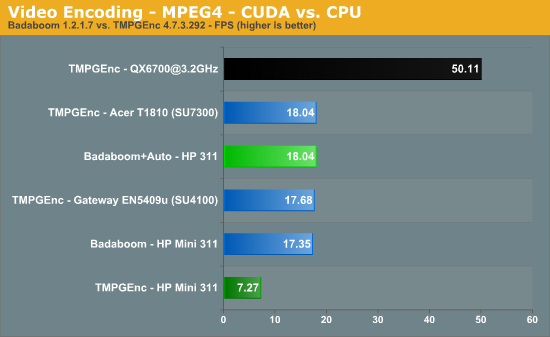HP Mini 311 — CUDA on ION
NVIDIA always likes to tout the advantages of their GPUs and CUDA. In theory, if you have a highly parallelizable task like video encoding/decoding/processing, you can accomplish that task a lot faster on a GPU than on a traditional CPU. When you add in the fact that Atom is already a very slow in-order architecture (albeit with Hyper-Threading), boosting performance of certain tasks could be very beneficial.
One of the applications NVIDIA talks about a lot with relation to CUDA is Badaboom. We haven't looked at in quite some time, and with the low performance of Atom CPUs it might be a viable option. We ran a test encode using Badaboom and a 720p source video, targeting the default "YouTube" output: 640x360 with 1000kbit VBR video and 128kbit MP3 audio. We also tweaked the Badaboom settings to enable auto key frame insertion for improved image quality and performance, which we'll see in a moment.
We can't run Badaboom on CPUs, unfortunately, so we used TMPGEnc 4.0 Xpress and similar settings: MPEG4 1000kbit video with 128kbit AAC audio. Interestingly, TMPGEnc also supports CUDA. However, the encoding is all done on the CPU, so the main benefit of CUDA for TMPGEnc is if you use some of the complex filters like noise reduction and smart sharpen. If you're just doing a straight video encode, CUDA doesn't appear to help TMPGEnc right now.
First up, here are the results, with CPU encoding time on an Acer Timeline 1810 as well as a desktop Core 2 Quad 3.2GHz thrown in for reference.

Badaboom ends up being about 2.5 times faster than doing the video encoding on the Atom N270. Hooray! It's also about the same speed as a Pentium SU4300, but an overclocked Kentsfield 3.2GHz CPU is still 2.8 times as fast. Can you do basic video encoding on the ION LE with Badaboom? Yes, but now let's discuss quality for a moment.
The highest quality encodes will always require multiple passes in order to provide a better analysis of how to best use the available file size. Badaboom doesn't support multiple passes, so we did a single-pass encode in TMPGEnc for comparison. File sizes are similar (4213KB TMPGEnc vs. 4205KB Badaboom). Below are the image captures of the encoded video.

Default Badaboom YouTube setting

Badaboom YouTube setting with Auto Key Frames

TMPGEnc 4.0 Express — Single pass MPEG4 AVC 1000kbit VBR (3000kbit max)
The initial encodes using the Badaboom YouTube defaults are, at times, horrific. The content of the source video (and the scene in particular) can make a big difference, but overall the default settings fail to produce optimal results. Fast motion content is the worst offender, but then doing a good compression of fast action content has always been a lot more difficult. Luckily, we determined that making one change — setting the Key Frame Mode to "Auto" instead of "Fixed" (with the default "Baseline" and not "Main" mode) — results in a much better image. We still give the quality lead to TMPGEnc — and if you do multiple passes, the gap widens — but as a compromise the CUDA-based Badaboom encoder can achieve some decent results. As for ION, it's not really fast enough to make CUDA compelling; a moderate CPU can easily produce better results. Move to a faster GPU (NVIDIA's GTX 260M does the same encode at around 82 FPS and GTX 280M is at 100 FPS) and CUDA can flex its muscles.
There are other concerns with Badaboom, however. We had quite a few sample videos that it wouldn't accept (including a standard MPEG2 video). We also had some issues with audio glitches — our test encoded video has a couple small gaps in the audio, and they're there every single time on multiple systems. It's a relatively easy to use tool, but ultimately it can provide encoding performance at the cost of flexibility and quality.
There are other CUDA applications, of course. We'll look at SimHD DVD up-sampling in our battery life tests for example. Another potentially useful tool is called vReveal, which can remove noise, improve contrast/lighting, and reduce shakiness in recorded videos. If you make videos with your cell phone or inexpensive digicam and you want to upload them to YouTube, vReveal might be worth a purchase. A better video recorder would be an even better purchase, of course.
Most of the CUDA tools at present focus on video (and to a lesser extent image) related activities, since these tend to be highly parallelizable. Anyone doing video editing/encoding work will want something far more powerful than an Atom-based netbook, even if it does have ION to help out. Ultimately, while CUDA is certainly interesting, we prefer a vendor-agnostic approach, and DirectCompute will hopefully provide that in the coming months (or years). We also need to maintain a balanced system — certain tasks still rely heavily on the CPU and aren't candidates for GPU acceleration — and Atom is nowhere near fast enough for a modern computer.










51 Comments
View All Comments
ninjackn - Monday, November 23, 2009 - link
I think a more fair comparison would be to mention all 3 tiers: netbooks, netbooks with video acceleration and CULV laptop. Netbooks have tempted me for a long while but the lack of ability to watch practically any video have long been a turn off from them.The ION netbooks are something like $100 more over a netbook without video acceleration. That $100 gets me the ability to watch youtube, hulu, 1080p H264 content and play games like plants vs zombies, WoW or Quake Live. Then for another $100 more I can get a laptop that can possibly do the same but have better battery life, build quality and start office faster? The $100 more is seeming less appearing, especially since it is a non-primary system.
It seems like an interesting trade off, a weaker GPU and more powerful CPU (CULV + 4500MHD) or a strong GPU and weaker CPU (Atom + ION). The ION is defiantly a stronger GPU than the 4500MHD but I’m interested as to how the balance of CPU/GPU will play out in benchmarks for reasonable games.
Also, if you buy a mini 311 with Windows 7 then it comes equipped with the full ION. Granted that ION LE really IS a full ION with the DX10 disabled through drivers but it can be enabled either through a BIOS hack or forcing full ION drivers. The Windows Experience Index score for gaming jumps from 3.9 to 5.4 I'm curious how that plays out (311+full ion vs timeline for "light" gaming).
As for video playback I have no idea if the 4500MHD is any good for H264 decoding. All I’ve heard about it is from forums or comments and I would really appreciate if there was a more definitive source (anandtech) discussing the matter. I glossed over the flash 10.1 article and it would seem that either are fine for youtube or hulu but what about videos we acquired through other means?
And talking as a "typical" anandtech-reader/power-user type of guy: The ion is more interesting over the 4500MHD because no apple laptop comes with a 4500MHD but they do come with a 9400M.
JarredWalton - Monday, November 23, 2009 - link
4500MHD provides enough GPU acceleration of x264/H.264/Flash decoding that when combined with a CULV CPU you can easily watch 1080p videos.The real comparison is Acer 1410/Gateway EC1435u (essentially the same thing) vs. the HP Mini 311. All are ~$400 base price, with a slight advantage in specs (i.e. RAM) to the Acer/Gateway CULV laptops.
I can't say for sure how the Celeron SU2300 stacks up to the Pentium SU4100, but half the cache and 100MHz should mean it's about 80-85% of the performance. That should still be enough for video decoding (I'll verify with Flash 10.1 on SU4100 in the next couple days).
For graphics, GMA 4500MHD is about 1/4 the gaming performance of 9400M, but Atom really holds 9400M (ION) back it seems. If the 9400M can only run at ~1/3 it's regular gaming performance because of CPU bottlenecking, we have a real fight. If it's more like 1/2 speed, it's not as close.
I'll be looking at all of this in the next week or so....
AstarothCY - Sunday, November 22, 2009 - link
The HP Mini 311 is multitouch-capable. Yes, the Windows 7 models ship with a driver that inexplicably does not recognize multitouch gestures, but if you install the following driver, they will work:http://h10025.www1.hp.com/ewfrf/wc/softwareDownloa...">http://h10025.www1.hp.com/ewfrf/wc/soft...%A9=en&a...
You may experience an issue with the function of the left touchpad button being unset from "Click", causing some issues after you wake up from hibernate, just make sure it is set properly. HP should really release a proper Mini 311 ALPS driver for Windows 7.
BelardA - Sunday, November 22, 2009 - link
Yeah, it sucks that some idiots decided that WE would want glossy LCD screens for our portable computers. *I HATE THEM*.But there are notebooks with WindowsXP & Windows7 with excellent matte screens.
They are called THINKPADS. Some of the cool-looking, lower end SL series has non-glossy screens. And the other series: R / T / X / W come with matte screens by default (Some are/were optional gloss).
So starting at about $550 (SL) or a typical SL / R with core2duo at $600~700 are matte screens.
I love my ThinkPad, and the screen was the #1 reason I bought it for $650. Many of my friends buy them now because of the screens and of course the quality. Something that HP can't touch.
BTW: I also like netbooks... for $250~300, willing to deal with the glossy. But it looks like a ThinkPad Netbook may come out and it has glossy :( (rumored)
cgramer - Monday, November 23, 2009 - link
FWIW, the Asus Eee PC 1000HE has a matte screen, though its case is as glossy as any of them (i.e., a fingerprint magnet).AstroGuardian - Monday, November 23, 2009 - link
ThinkPads are marvelous piece of technology. Definitely untouchable by competition. But costly also!fokka - Sunday, November 22, 2009 - link
dell (and afaik hp) buisnes-lineups also offer matte sceens, though at least in the dell vostros, they arent that great considering viewing angles, contrast, colour.Etern205 - Sunday, November 22, 2009 - link
The HP mini 311 uses DDR3 not DDR2 as you guys have stated in the specifications table.JarredWalton - Sunday, November 22, 2009 - link
Sorry... typical cut/paste typo. :)irev210 - Sunday, November 22, 2009 - link
Lots of talk between comparing the Acer 1810 to the ion platform.You can get the 399 dual core celeron CULV for 399 in the acer timeline 1410.
The HP ion platform vs the Acer celly CULV platform is a no brainer comparison, as they are both 399.
Acer celly CULV is by far the best value in the netbook space atm.